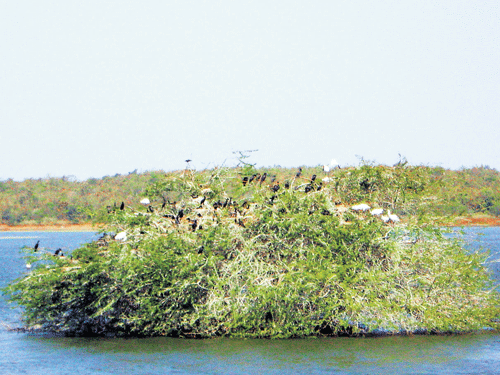
A refuge for migratory birds, Attiveri Bird Sanctuary is the perfect place to go this summer, writes K Karunakaran
Attiveri is an idyllic location where birding and nature enthusiasts are welcomed by the melodious voices of innumerable varieties of winged beauties, of course, majority of them qualifying to be seasonal visitors from foreign country habitats located far away. Mother nature also greets you with her fresh and unpolluted air here.
This little haven for birdies is located about 15 km from Mundgod (where we find the Tibetan Settlement) and around 47 km from Hubli. A two-hour drive from Dharwad will take you through a reasonably good road traversing in serpentine fashion through the deciduous forests of Yellapur, to the Attiveri Bird Sanctuary in North Kanara district of Karnataka.
This place is far from the maddening crowds, and there are just a few tiny hamlets in the periphery. You will also not find an abundance of plastic-waste and other pollutants, which are usually left behind by the so-called civilised visitors.
Humble beginnings
It all started with the construction of a dam across the river Tayawwana Halla, in the Yellapur Forest Division, for irrigation purpose. The dam was commissioned in the year 1992. As the result of this, a large reservoir was formed in and around Attiveri village. Formation of the water body in an area of about one square km resulted in partial submergence of the natural forest around the area.
The partially submerged trees which managed to survive in the reservoir, along with a few small islets eventually started attracting many varieties of feathered beauties, both local and also foreign with a penchant for migration.
As the reservoir is located in the midst of a moist deciduous forest in a calm and serene environment with abundant feeding grounds, Attiveri soon became a haven for the birds to seek refuge there for their seasonal breeding activities. The vast farmlands and irrigation tanks in the peripheral areas also help the birds to nest, feed and breed, thus making this locale an ideal aquatic and avian habitat.
Although Attiveri was notified as a bird sanctuary in 1994 by the Government of Karnataka, only six years later (in 2000) was it declared as a full-fledged bird sanctuary. The sanctuary covers a total area of 2.23 sq.km, of which the reservoir takes up 1 sq.km, and the rest consists of forests. It is estimated that around 80 species of birds from 22 countries come to Attiveri for their winter sojourn.
A bird’s paradise
Attiveri could undoubtedly be considered as a typical mini-paradise for birdies, where sightings are almost assured during the season. A long and narrow concrete ramp walkway has been constructed along the boundary of the lake, partially through the water body.
This is very useful for birding enthusiasts to get an opportunity to meet their favourites at very close quarters, for observation as well as clicking a few snaps.
Along with the camera, it would be wise to carry a pair of binoculars also. Common sightings at this abode include the Indian cormorant, little cormorant, great egret, little egret, Indian pond heron, green bee-eater, grey francolin, darter, black-headed ibis, Eurasian spoonbill, kingfisher and white ibis.
Unperturbed by human visitors, you may see a few large white ibises shooting across, flaunting their distinctive brilliant white plumage and contrasting black primary feathers, wings flapping rhythmically, a few feet above the surface of the lake, to the safer tree-tops.
It is easy to spot a few grey and purple herons among their white companions. Many shining black cormorants may be found perched on the branches of the trees in the water in sharp contrast to other white birds, enjoying the warm sunshine.
A group of hungry spoonbills could be seen rummaging through the shallow water around a tree near the walkway. A few little egrets along with some white ibises may be swimming gracefully on the surface of the waters, with their heads and necks dipping under, looking for fish. Fish are in plenty in the lake, and can be noticed clearly darting through the bottom near the shallow parts around the walkway.
Mixed groups of water birds would be perching on the branches of the half-submerged tree-tops, amidst groups of nests full of cherubic fledglings chirping non-stop or crying out to their parents in unison at the top of their feeble voices, while flapping their tiny, tender wings, in many of them.
Some doting parents could be busy feeding their ever-hungry chicks with wholesome morsels of fish meticulously. Territorial quarrels and petty fights could also be witnessed sometimes, when the bigger birds try to chase away the smaller ones on the already overcrowded tree tops.
It is easy to sight a lonely white-breasted kingfisher sitting in reverent meditation at the tip of a dry branch sticking out of the lake. You are sure to notice his bright blue back, wings and tail, chestnut shaded head, shoulders, flanks and lower belly, the white throat and breast, bright red bill and legs.
The adjoining deciduous forests are also home to many varieties of birds, as well as wild animals. Birds like the rose-ringed parakeet, the common Indian cuckoo, brown shrike, bay-backed shrike, southern grey shrike, peafowl, barn swallow, and common grey hornbill are said to be found in the forests.
Cuckoos and flame-throated and white-browed bulbuls can be sighted inside the small park near the entry point to the sanctuary, which is full of trees and flowering plants. Animal sightings reported in the surrounding forests include wild bears, porcupines, jackals, hares, mongooses, pythons and other varieties of snakes.
The best time to visit this sanctuary is November-March, when the foreign feathered visitors arrive in large numbers in accordance to their seasonal winter migratory itinerary.
Deccan Herald is on WhatsApp Channels| Join now for Breaking News & Editor's Picks